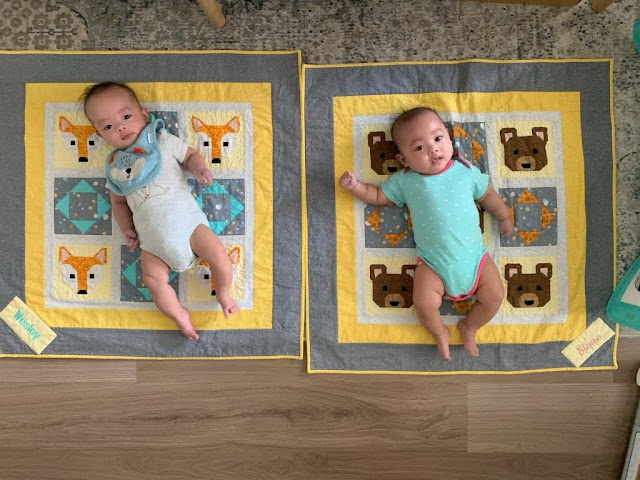One of the students in my ESL class is an amazing artist. Her favorite motif is repeating shapes, often with a geometric arrangement. Several times over the last two years, she made bookmarks for every other student in the class, each featuring a unique design!
This spring, she presented me with this piece:
Beautiful, right!!!! And it is only 5" x 6"!
She knows that I am a quilter (we have shared our work with each other), so she said she hoped I could make a quilt based on this design. Challenge accepted!
The first thing to take note of is this: Clearly there are 12 wedges (thus, each must be 30 degrees). At first sight, it appears that it is the same segment repeated 12 times. But look again closely. If we start at the top middle and go clockwise, you can see that the odd sections (1, 3, 5, 7, 9, 11) are slightly different from the even ones! If you still can't see it, look at the shape of the black "triangles".
The best way to create such wedges, with their crazy angles and small pieces, is with the paper piecing technique. That meant I would need to create a pattern for the 6 odd-numbered wedges and a slightly different pattern for the 6 even-numbered wedges.
Her design of each wedge initially appears to be very simple. Some stripes and rectangles and lines.
How to translate this into fabric?
I used this design as a starting point. No way would I try to find fabrics with the exact patterns on her drawing. Trying to do so and getting them in complementary colors would be a fool's errand. So, I would have to use fabrics that gave the same feel or appearance as the original.
How big to make it? Obviously, having a finished quilt at 5" x 6" is somewhat foolish (unless you're decorating a doll house), and to do a paper pieces one of that size would be next to impossible. I did some rough calculations and came up with a workable length of about 11" for the longer edges (the left side of the odd pieces!); the edges of the odd pieces are a little shorter. The outer background could then be whatever extra size would make sense overall. This would give a total size of about 22" x 24".
Once I made that decision, the next question was how much of her design should I try to replicate? Since each wedge was fairly small and made up of a number of pieces, I had to eliminate some of the smaller details. So I took a copy of her original, and, using paper scraps to "edit" and drawing in some revised lines, I came up with a design that could be done in cloth. Since each wedge is made up of several different fabrics, the total amount of any particular one is very small (less than an eighth of a yard).
At that point, it just made sense to use fabrics I had in my stash. The original is blue, and blue is my favorite color, so naturally I have the most fabrics in that color. But try as I might, I could not find the right ones to work here. 😒 The greens seemed like the next best candidate, and yes! I found just the right mix of colors and patterns.
Everything was falling into place!
Next I went to the local copy shop to make a full-sized enlargement. 400x ought to do it:
I then used special paper-piecing paper to trace each odd and even segment. Then I had to cut each of those into the sub-sections. For example: there might be A1 and A2 as one subset in an Odd wedge; B1, B2, B3 as another. Then draw the seam allowance around each and mark each sub-piece with an identifier for the correct fabric. Then make a final copy (actually 6 of each) for the odds and evens.
Next: putting it together. It was just a matter of sewing each sub-section together, then sewing Set A to Set B, etc., then sew the wedges together. One difficult part was the white outer background. These parts were not included as part of the wedge since:
a) it would have been too big to fit on one sheet of paper, and
b) each white area is a little different based on which wedge (1 - 12) it is attached to.
So after making each wedge, I just added a large piece of white in roughly the shape needed. Then I trimmed them to fit. Looking back now, it would just have been better to add large white triangles (and the strips on the sides) after each 3-wedge group had been sewn together (fewer background seams that way).
I also decided to put a thin green border which echoed the thin fabric strips in the wedges.
Quilting was minimal: ditch quilting on the 12 wedge seams using clear monofilament thread. Then a ditch of white thread in the background - border seam.
Finally, I wrapped it canvas-style around wooden stretcher bars. It's now ready for hanging.
Hopefully, this does justice to the original.
I will be gifting this piece to my artist-student-friend. But you may have noticed that this quilt does not yet have a name. I asked her what she called her original piece and she said there was no title for it. We tried to think of a name, but couldn't come up with one. So I am asking my loyal followers to submit their suggestion (either as a blog comment or directly to my email). We will pick the best one and then I will give her the quilt (and update this post).
Thanks to all who submitted name suggestions. As you can see, the winner was "QFL". What does that mean? Quilting as a First Language! Because art is the language that all people speak and understand.











































